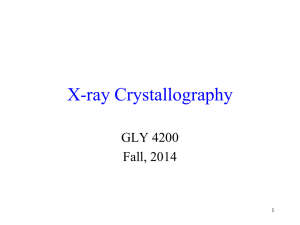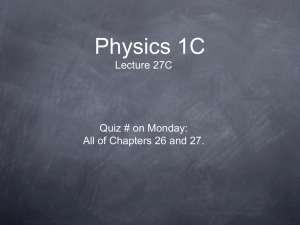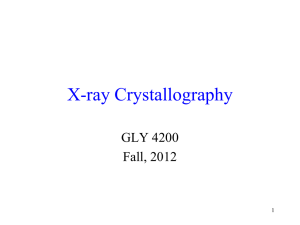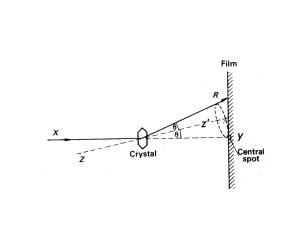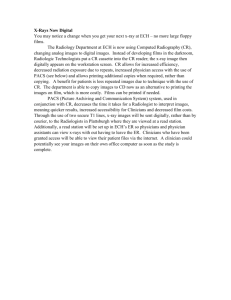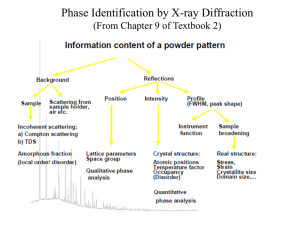Applied Modern Physics
advertisement
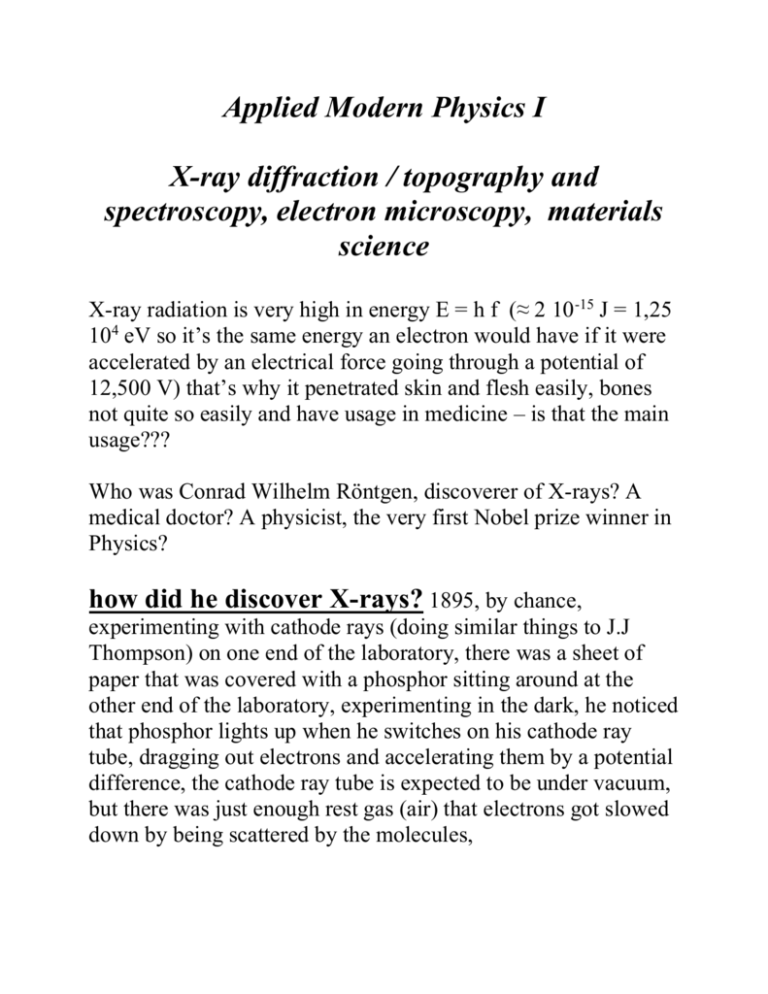
Applied Modern Physics I X-ray diffraction / topography and spectroscopy, electron microscopy, materials science X-ray radiation is very high in energy E = h f (≈ 2 10-15 J = 1,25 104 eV so it’s the same energy an electron would have if it were accelerated by an electrical force going through a potential of 12,500 V) that’s why it penetrated skin and flesh easily, bones not quite so easily and have usage in medicine – is that the main usage??? Who was Conrad Wilhelm Röntgen, discoverer of X-rays? A medical doctor? A physicist, the very first Nobel prize winner in Physics? how did he discover X-rays? 1895, by chance, experimenting with cathode rays (doing similar things to J.J Thompson) on one end of the laboratory, there was a sheet of paper that was covered with a phosphor sitting around at the other end of the laboratory, experimenting in the dark, he noticed that phosphor lights up when he switches on his cathode ray tube, dragging out electrons and accelerating them by a potential difference, the cathode ray tube is expected to be under vacuum, but there was just enough rest gas (air) that electrons got slowed down by being scattered by the molecules, today we know: when electrons are slowed down they radiate off their lost in kinetic energy – and that is X-rays an electromagnetic wave + a stream of high energy photons traveling at the speed of light at the time nobody knows how the radiation originates and of what kind it was: wave or particles? Röntgen could in a long series of experiments showed: - X-rays penetrate all substances to some extend, elements of low atomic weight are especially transparent, elements of high atomic number can bye used as shields for protection against Xrays - X-rays cause many substances to fluoresce, i.e. absorbing them and radiating off electron-magnetic waves of a different wavelength - X-rays are not deflected in a magnetic field, so they do not consist of charged particles - X-rays can effectively be generated by “cathode rays = accelerated electrons” fall on a metal anode (and any other material placed in their path - X-rays ionize the gasses through which they pass, causing an increase of electrical conductivity but not diffraction which would prove X-rays are to be described by waves! reason: then - of course - unknown, the wavelength of X-rays is so small that there were no manmade diffraction gratings available how does a diffraction at a grating differ from that of a double slit arrangement? a diffraction grating has a much much greater number of slits for the positions of the maxima d sin θ = m λ where m = 0, 1, 2, … are called the order of the line and d is called the grating period, i.e. quotient of some length W divided by the number of lines as the maxima of the lines is very well defined and narrow, one can measure the wavelength of the incident (mono- or polychromatic if it is not too many) radiation that produced the interference/diffraction pattern (for a double slit experiment the bright fringes arising from different wavelength light would overlap too much to be distinguished by 1912, Sommerfeld at the Physics Department of University of Munich, nominated 80 times for Nobel prize without ever winning it, died from a car accident had calculated an order of magnitude for the wavelength of X-rays: 0.1 nm if that were to be true, wavelength would be so short that diffraction of 0.1 nm X-rays from a standard optical grating of period 3 μm were to give diffraction angle of 0.002° so pessimism, how is somebody going to prove X-rays are waves or not a PhD student of Sommerfeld, Ewald working on solid state theory implications what if crystals were, as some of the leading mineralogist (e.g. Victor M. Goldsmith at the Mineralogy Department of U of Munich) expected a three-dimensional ordered arrangement of atoms with inter-atomic distances of the order of magnitude 0.1 nm – you have to pause here, the very existence of atoms was not well established at that time let alone their possible arrangement in crystalline solids, approached Max Laue (an assistant professor at Sommerfeld’s chair) at Café “Lutz”, where students and faculty used to hang out, on an quite unrelated matter Laue was at that time working on a treatise on classical optics and heard for the first time both hypotheses, that the wavelength of X-rays may be as short at 0.1 nm and that crystals may possess a possible periodic arrangement of the atoms in 3 dimensions with a spacing of the order of magnitude 0.1 nm on their way back to the Physics department, the idea occurred to Laue, well, there should be interferences if a crystal is exposed by a beam of “sufficiently monochromatic” X-rays he himself being a theorist, he talked a postdoc, Friedrich, who had previously worked with Röntgen) and a postgraduate, Knipping, into trying the experiment, behind the back of the big boss, Sommerfeld, when Sommerfeld heard about it he was furious especially as they didn’t get the results Laue expected as they didn’t know where to look for - so the project came to an halt Laue finally got permission to go ahead but the big boss was still convinced it was a stupid experiment as he calculated, even if there were X-ray interferences, the thermal motion of the atoms at their respective places in a crystal would smear them out. little did he know … and Max von Laue, i.e. he got knighted, got for the correct interpretation of the intensity maxima and the development of the so called kinematic theory of X-ray diffraction his 1914 Nobel prize. what was found in one experiment not only that X-rays do indeed possess waves properties and that crystals indeed possess a three dimensional arrangement of atoms, but also nothing less than the discovery of a method to probe the inner structure of crystalline matter, which we know today is almost all solids, be they metals, ceramics, semiconductors, …. (not glass, rubber, and certain plastics) a diffraction grating is really a one dimensional thing, the naturally occurring crystals are, however, 3 dimensional, therefore we get a slightly different relation for the distribution on intensity on a screen of photograph Bragg’s equation: n λ = 2 d sin θ where n is order of reflection allowing crystals to be used as kind of a grating for measuring wave length of characteristic X-rays which arise from electronic transitions of the innermost electrons and analysis of crystals structures, solids in general as a matter of fact a new science was enabled which goes by the name materials science/crystallography new sciences always start out as a parepistemes (R.W. Cahn) from the ancient Greek: episteme – meaning a domain of knowledge par - means amongst other things subsidiary i.e. a subsidiary subject within a science is something right at the fringes of attention and funding that does not primarily aim for solving any practical problem, people only do it for the fun of it, because they find it interesting. Chan described it as: “looking at the forest, not just selecting a tree for logging …” later on, electron, and neutron diffraction, which are complementary to X-ray diffraction – the single most important tools of materials science a science in its own right? It’s a science when it has its own journals, conferences, societies, institutionalized departments, degrees, graduate students, … when it has something unique that distinguishes it from the science that gave birth to it (which is probably always Physics) what is unique about materials science/crystallography? R.W Chan: “… the materials scientist has to work at several levels of organization, each of which is underpinned by the next level. Here, again, he is brother under the skin of the biologist, who does just the same: staring with the cell wall, say, the goes on to study the morphology and economy of the cell as a whole, then the isolated organ (made of cells), then the organism as a whole. … the concept of microstructure is the most important single definition theme of Materials Science and Engineering.” perhaps something is a science when it has spun off an engineering discipline, what do you think? perhaps something is a science when consistently Nobel prizes have been awarded in that field, what do you think? Nobel prizes Physics: 1914 Max von Laue, X-rays are an electromagnetic wave of about 0.1 nm wavelength, atoms in crystals are arranged in a regular 3D lattice with spacing in the 0.1 nm range, there is Xray diffraction from crystals, the possibility of analyzing the arrangements of matter in crystals, (Laue equations), 1912 1915 Sir William Henry Bragg and William Lawrence Bragg (son of the former), X-ray crystallography, W.L. Bragg equation, X-ray crystal spectrometer, 1913 1937 Clinton Davidson and Sir George P. Thompson (J.J. Thompson’s son who first showed electrons are particles), electron diffraction by crystals, in other words electrons are waves, 1927 1986 Ernst Ruska, inventing the electron microscope where one operation mode is electron diffraction (1931) together with Gerd Binning and Heinrich Rohrer, scanning tunneling microscope, (completely unrelated) 1994 Bertram N. Brockhouse and Clifford G. Schull, pioneering neutron diffraction and spectroscopy Nobel Prizes Chemistry 1936 Peter J. Debye X-ray and electron diffraction analyses of molecules 1962 Max F. Perutz, John C. Kendrew X-ray diffraction analysis of haemoglobin und myoglobin 1964 Dame Dorothy Crowfoot Hodgkin X-ray diffraction analysis of biochemical macromolecules 1976 William N. Lipscomb X-ray diffraction analysis of borhydrids 1982 Aaron Klug X-ray diffraction analysis of nucleic acids and protein complexes 1985 Herbert A. Hauptmann, Jerome Karle direct methods of X-ray crystallography 1988 Johann Deisenhofer, Robert Huber, Hartmut Michel structure and function of protein-chromophor-complex Nobel Prize Medicine 1962 James D. Watson, Francis H.C. Crick, Maurice H.F. Wilkins, X-ray diffraction analysis of DNA and its importance for genetic code note there has not been any Nobel prize for medical Xrays, so probably that was much less important to the development of mankind as the physical and crystallographic use of X-rays so in a sense: Materials Science/Crystallography is the real legacy of Konrad Willhem Röntgen, what happened to him, he got the first ever Nobel prize in Physics in 1901, but refused to accept the money, during the hyperinflation following world war I, he died a very poor man from malnutrition, exhaustion, and poor health due to his experiments with X-rays
